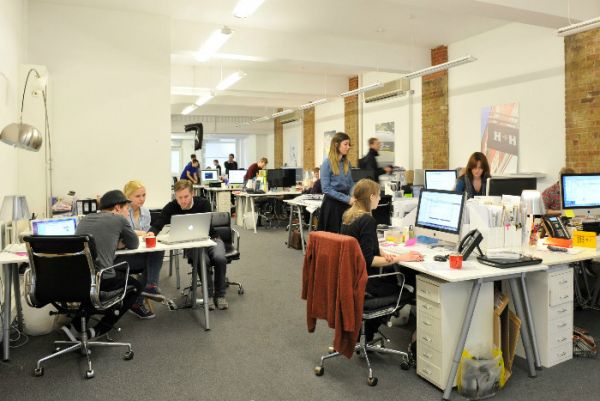In the United States, more than 70 per cent of offices now have no or low partitions, according to the International Facilities Management Association.
Whilst the most immediate benefit of such environments obviously revolves around the ability of organisations to minimise space requirements and therefore occupancy costs, proponents of this way of working say the advantages it delivers extend beyond this.
Open plan layouts, they say, facilitate interaction and collaboration, generate a greater sense of camaraderie and offer a less formalised way of working compared with knocking on office doors. This allows for not just greater levels of communication but also the breaking down of hierarchies and barriers along with the creation of a more open and transparent culture. Concepts such as hot-desking and activity based working, meanwhile, are enabling companies to redesign their workplaces in order to improve space utilisation and better match workplace layout with the way in which their staff prefer to work.
However, academics are increasingly beginning to question the notion of open plan arrangements really benefiting workers. Drawing on post occupancy surveys of more than 42,000 workers across the USA, Finland, Canada and Australia, for example, Sydney University Professor Richard de Dear and PhD candidate Jungsoo Kim found that compared with those in private offices, staff in open plan spaces were less satisfied with their workplace environment as benefits associated with being close to co-workers were offset by disadvantages associated with noise, disruption and loss of privacy.
In 2011, the Scandinavian Journal of Work, Environment & Health reported that on average, workers in open plan environments took 62 per cent more sick days compared with those in traditional private offices. Around 95 per cent of workers in one Steelcase research study indicated that privacy is important to them, whilst a 2013 Gensler study found that workers spent 54 per cent of their time on tasks requiring deep concentration; conditions which do not traditionally jell effectively with open plan layouts.
Scepticism is also making its way into media reports. In a 2014 article in theWashington Post, Brooklyn-based advertising worker and writer Lindsey Kauffman wrote that Google and other Silicon Valley companies had ‘got it wrong’ in their shift toward open plan. She associated her own experience with being moved from a private office to a seat at a long, shared table one year earlier with a loss of privacy, being subject to loud music and noise, and a feeling of being ‘watched’ during the time of her departure at the end of the day or when getting up in order to get a drink or visit the bathroom.
In February, an article by David Walker in CPA Australia’s In the Black magazine described open plan layouts as ‘a flawed plan’ and suggested that designers and their clients who embraced this type of layout were ‘either misguided or putting costs first.’
Not everyone is looking to open plan offices. In Sydney, for example, email marketing campaign management software startup outfit Campaign Monitor has gone the other way in favour of individual offices in order to provide its programmers with space which is relatively free from distraction.
So does open plan space really work? In order to answer that question, it is important to bear in mind that ‘open plan’ no longer necessarily constitutes a linear type of concept involving workers sitting in fixed, permanent locations but indeed can entail a variety of design layouts. Under one such model known as hot-desking, individual workstations are not ‘owned’ by a single employee but are instead used by multiple staff at different times. This arrangement is sometimes used by companies whose workers typically spend considerable amounts of time working at home and who wish to use company space and resources with greater efficiency.
Going further, an increasingly popular arrangement known as activity based working sees workers again not sit at a fixed location but instead move freely around different ‘zones’ according to whether they needed to collaborate, perform tasks requiring intensive concentration or hold meetings at which confidential information is being discussed. For this reason, debate surrounding the virtues or drawbacks of open plan offices must take into account of the multi-dimensional nature of the modern open plan concept.
Indeed, a number of organisations are re-thinking and re-designing the way in which they work. Prior to moving from its former office at 333 George Street in Sydney to its current location across the street at 1 Martin Place, for example, commercial property management outfit Charter Hall was operating in an environment which consisted of meeting rooms, two offices for managing directors and open plan individual desks for everyone else. There was little in the way of areas in which collaboration was able to take place easily and naturally or in which workers performing tasks requiring intensive concentration could access quieter spaces. At the time of the move, the company was undergoing a cultural shift and had identified the opportunity to design its new environment in such a way as to facilitate the fostering or core values such as passion, accountability and collaboration.
Although the company operates two floors, for example, communication of a serendipitous nature is encouraged by having entry on the first floor only, with the two floors linked via a stairway. Interaction is further encouraged by having staff eat together in one spot and having all lockers together in another.
In terms of actual work spaces, a variety of different zones enable workers to choose locations based upon the type of task they are undertaking, including day to day processing centres where people are able to work on or around computers but are able and encouraged to speak, ‘bunkers’ where individuals or two colleagues requiring sustained periods of high concentration can go, ‘high focus areas’ which enable staff to work at a desk but at which noise is not permitted and a flexible learning space designed around a backyard style with cubbies and sheds. Meeting rooms are used only where confidentiality is required or the nature of the meeting is such that considerable volumes of space are needed.
Whilst greater efficiency of space was delivered through this process, Charter Hall head of people, brand and community Natalie Devlin said the focus revolved much more around a cultural play aimed around fostering collaboration, accountability and flexibility in the way people work.
“The idea is that your first thought will be, ‘who am I going to collaborate with on what and which is the environment in which I am going to do it?’” Devlin said.
So do open plans truly boost productivity or are they really a cost cutting exercise? According to CBRE head of workplace strategies Matt Strudwick, both are actually true. He says companies which focus primarily upon a cost cutting mindset can potentially see a negative impact upon employee morale and productivity on one hand but adds that the opposite holds true with companies which think more broadly about the function their offices serve and the way in which these can assist staff to derive maximum value out of their workplace.
He says the critical factor for organisations in moving toward open plan revolves around engaging in meaningful dialogue with staff about what employees want from their office based workspace, how they like to work and what the office workspace enables them to do as opposed to working from home or on client sites.
“A lot of organisations do see (open plan) as cost cutting. When that is the case, there is an almost guaranteed hit in some way, shape or form to productivity,” Strudwick said.
“Then you have got a camp who really thinks about the right direction for their organisation and how they define productivity in terms of their workplace and the ROI they are looking for on their workplace. That camp definitely sees benefits.
“It all comes down in my mind to your intention in your move toward open plan. Is this an intention to move toward a form of outcome for the business in terms of productivity, employee engagement and retention and collaboration or is this the property department or finance guys seeing it as a more efficient way to do things?”
According to leading workspace designers, meanwhile, there is definitely an argument to be made for open plan in the right environment and for the right type of organisation.
Daniel Malton, a director of Melbourne-based fitout, design, construction, building and maintenance outfit Symmetry Commercial says the choice of open plan or otherwise ultimately comes down to a question of values and what the organisation is trying to achieve. Whilst this type of arrangement is unlikely to be suitable for clients such as law firms on the basis of confidentiality considerations, Malton said, it may well be appropriate for smaller, startup type companies.
Dr Donna Wheatley, a Sydney-based team leader of workplace strategy and design and a sessional academic at the University of New South Wales, meanwhile, said the push toward open plan was not necessarily being driven by cost reduction or a desire to boost productivity but more typically a desire to achieve both. Along with cost benefits in terms of reduced floor space requirements, Wheatley says open plan layouts enable people and equipment to be easily shifted in response to shrinking or expanding headcount. They can also facilitate greater usage of space at a time when research is generally putting peak usage rates at no greater than 70 per cent. Moreover, a desire to deliver benefits to workers through this process was an “absolutely genuine desire on the part of the corporation,” she said.
“They are not doing this because they think it will lead to worse outcomes,” Wheatley said. “It’s not trying to take things away from staff for efficiency gains in terms of rental for space required. They (productivity benefits) are genuine desires on the part of the company.”
From an employer perspective, meanwhile, a number of firms say much of the push on their part is being directed toward better meeting the needs of their workers. Cisco lead workplace manager John Corbett, for example, said that the company had been purposeful and structured in its approach toward minimising space requirements in the past and that current program involving efforts to alter the layout of its Sydney office revolved around a drive to make better use of space and to more effectively match the workplace to the needs of staff.
Engagement with Cisco’s workers, Corbett said, had uncovered that many had become frustrated with considerable volumes of noise and little in the way of support areas, with frustration primarily revolving not so much around being able to find seats but rather not being able to find spaces which are conducive to what they needed to do or to come together to workshop ideas.
Wheatley acknowledges the veracity of the aforementioned University of Sydney study but cautions that data for that study begun to be collected as early as 2000 and thus may partially be responding to a pre-mobile and digital era. During that time, open desk based environments were noisy, none of the flexibility offered by activity based working or opportunities to work from home existed and many of the senior people still had individual offices. In such an environment, the concept of open plan may have been viewed less favourably compared with how it is seen now.
Strudwick, meanwhile, says much of the research adopts narrow definitions of productivity and tends to be based upon assumptions about what may be desirable in the workplace (e.g. private space) which may or may not hold true amongst modern day workers.
As for outcomes, Devlin says Charter Hall’s ‘engagement score’ with its workers has risen by 30 per cent and staff turnover has halved since its move into its new place with the new arrangements, whilst Malton adds that companies such as Deloitte, which have gone the way of open plan, regularly feature in lists of best places to work.
Of various shapes and sizes, open plan styles of office layouts are on the rise.
If thoughtfully and carefully planned, it seems, this may well be good news for workers.


